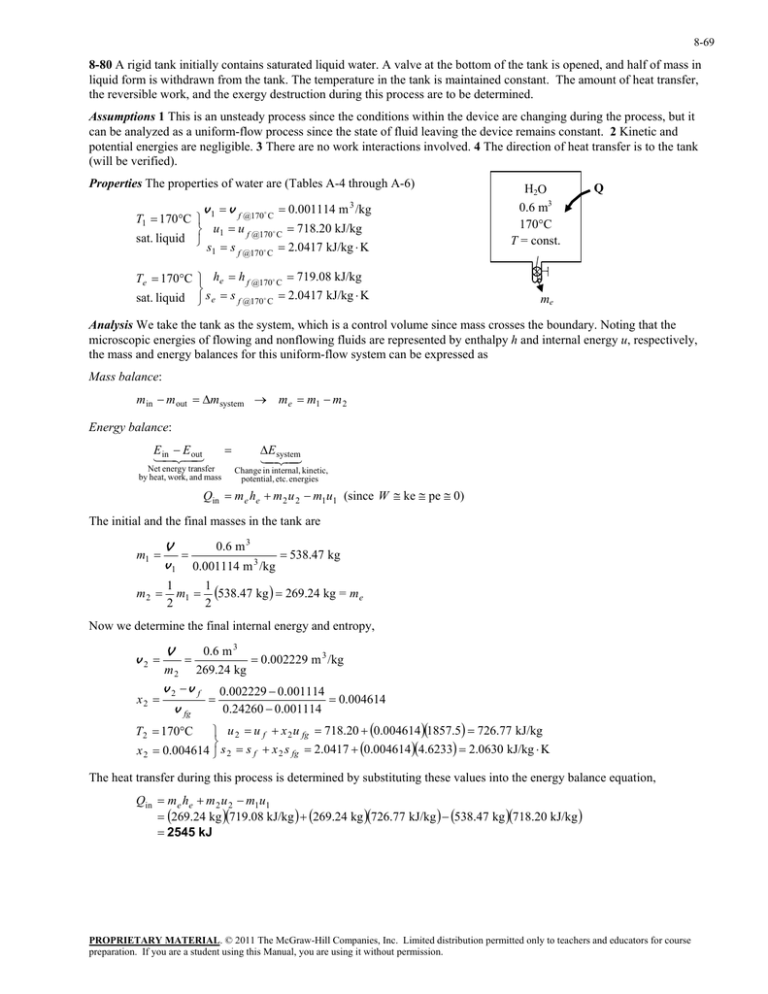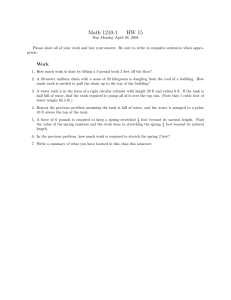liquid form is withdrawn from the tank. The temperature in... 8-80
advertisement

8-69 8-80 A rigid tank initially contains saturated liquid water. A valve at the bottom of the tank is opened, and half of mass in liquid form is withdrawn from the tank. The temperature in the tank is maintained constant. The amount of heat transfer, the reversible work, and the exergy destruction during this process are to be determined. Assumptions 1 This is an unsteady process since the conditions within the device are changing during the process, but it can be analyzed as a uniform-flow process since the state of fluid leaving the device remains constant. 2 Kinetic and potential energies are negligible. 3 There are no work interactions involved. 4 The direction of heat transfer is to the tank (will be verified). Properties The properties of water are (Tables A-4 through A-6) v 1 v f @170 C 0.001114 m /kg T1 170C u1 u f @170 C 718.20 kJ/kg sat. liquid s1 s f @170 C 2.0417 kJ/kg K 3 Te 170C he h f @170 C 719.08 kJ/kg sat. liquid s e s f @170 C 2.0417 kJ/kg K H2O 0.6 m3 170C T = const. Q me Analysis We take the tank as the system, which is a control volume since mass crosses the boundary. Noting that the microscopic energies of flowing and nonflowing fluids are represented by enthalpy h and internal energy u, respectively, the mass and energy balances for this uniform-flow system can be expressed as Mass balance: min m out msystem m e m1 m 2 Energy balance: E E inout Net energy transfer by heat, work, and mass E system Change in internal, kinetic, potential, etc. energies Qin m e he m 2 u 2 m1u1 (since W ke pe 0) The initial and the final masses in the tank are m1 0.6 m 3 V 538.47 kg v 1 0.001114 m 3 /kg m2 1 1 m1 538.47 kg 269.24 kg = m e 2 2 Now we determine the final internal energy and entropy, v2 x2 V m2 0.6 m 3 0.002229 m 3 /kg 269.24 kg v 2 v f v fg 0.002229 0.001114 0.004614 0.24260 0.001114 u 2 u f x 2 u fg 718.20 0.004614 1857.5 726.77 kJ/kg x 2 0.004614 s 2 s f x 2 s fg 2.0417 0.004614 4.6233 2.0630 kJ/kg K T2 170C The heat transfer during this process is determined by substituting these values into the energy balance equation, Qin m e he m 2 u 2 m1u1 269.24 kg 719.08 kJ/kg 269.24 kg 726.77 kJ/kg 538.47 kg 718.20 kJ/kg 2545 kJ PROPRIETARY MATERIAL. © 2011 The McGraw-Hill Companies, Inc. Limited distribution permitted only to teachers and educators for course preparation. If you are a student using this Manual, you are using it without permission. 8-70 (b) The exergy destroyed during a process can be determined from an exergy balance or directly from its definition X destroyed T0 S gen . The entropy generation Sgen in this case is determined from an entropy balance on an extended system that includes the tank and the region between the tank and the source so that the boundary temperature of the extended system at the location of heat transfer is the source temperature Tsource at all times. It gives S in S out Net entropy transfer by heat and mass S gen S system Entropy generation Change in entropy Qin m e s e S gen S tank = (m 2 s 2 m1 s1 ) tank Tb,in S gen m 2 s 2 m1 s1 m e s e Qin Tsource Substituting, the exergy destruction is determined to be Q X destroyed T0 S gen T0 m 2 s 2 m1 s1 m e s e in Tsource (298 K)269.24 2.0630 538.47 2.0417 + 269.24 2.0417 (2545 kJ)/(523 K) 141.2 kJ For processes that involve no actual work, the reversible work output and exergy destruction are identical. Therefore, X destroyed W rev,out Wact,out W rev,out X destroyed 141.2 kJ PROPRIETARY MATERIAL. © 2011 The McGraw-Hill Companies, Inc. Limited distribution permitted only to teachers and educators for course preparation. If you are a student using this Manual, you are using it without permission.






